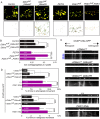PINK1-mediated phosphorylation of Miro inhibits synaptic growth and protects dopaminergic neurons in Drosophila
- PMID: 25376463
- PMCID: PMC4223694
- DOI: 10.1038/srep06962
PINK1-mediated phosphorylation of Miro inhibits synaptic growth and protects dopaminergic neurons in Drosophila
Abstract
Mutations in the mitochondrial Ser/Thr kinase PINK1 cause Parkinson's disease. One of the substrates of PINK1 is the outer mitochondrial membrane protein Miro, which regulates mitochondrial transport. In this study, we uncovered novel physiological functions of PINK1-mediated phosphorylation of Miro, using Drosophila as a model. We replaced endogenous Drosophila Miro (DMiro) with transgenically expressed wildtype, or mutant DMiro predicted to resist PINK1-mediated phosphorylation. We found that the expression of phospho-resistant DMiro in a DMiro null mutant background phenocopied a subset of phenotypes of PINK1 null. Specifically, phospho-resistant DMiro increased mitochondrial movement and synaptic growth at larval neuromuscular junctions, and decreased the number of dopaminergic neurons in adult brains. Therefore, PINK1 may inhibit synaptic growth and protect dopaminergic neurons by phosphorylating DMiro. Furthermore, muscle degeneration, swollen mitochondria and locomotor defects found in PINK1 null flies were not observed in phospho-resistant DMiro flies. Thus, our study established an in vivo platform to define functional consequences of PINK1-mediated phosphorylation of its substrates.
Figures







Similar articles
-
Parkinson's disease-associated kinase PINK1 regulates Miro protein level and axonal transport of mitochondria.PLoS Genet. 2012;8(3):e1002537. doi: 10.1371/journal.pgen.1002537. Epub 2012 Mar 1. PLoS Genet. 2012. PMID: 22396657 Free PMC article.
-
Altered ER-mitochondria contact impacts mitochondria calcium homeostasis and contributes to neurodegeneration in vivo in disease models.Proc Natl Acad Sci U S A. 2018 Sep 18;115(38):E8844-E8853. doi: 10.1073/pnas.1721136115. Epub 2018 Sep 5. Proc Natl Acad Sci U S A. 2018. PMID: 30185553 Free PMC article.
-
The GTPase dMiro is required for axonal transport of mitochondria to Drosophila synapses.Neuron. 2005 Aug 4;47(3):379-93. doi: 10.1016/j.neuron.2005.06.027. Neuron. 2005. PMID: 16055062
-
PINK1-Parkin signaling in Parkinson's disease: Lessons from Drosophila.Neurosci Res. 2020 Oct;159:40-46. doi: 10.1016/j.neures.2020.01.016. Epub 2020 Feb 6. Neurosci Res. 2020. PMID: 32035987 Review.
-
PINK1 as a molecular checkpoint in the maintenance of mitochondrial function and integrity.Mol Cells. 2012 Jul;34(1):7-13. doi: 10.1007/s10059-012-0100-8. Epub 2012 May 18. Mol Cells. 2012. PMID: 22610403 Free PMC article. Review.
Cited by
-
Drosophila MIC60/mitofilin conducts dual roles in mitochondrial motility and crista structure.Mol Biol Cell. 2017 Nov 15;28(24):3471-3479. doi: 10.1091/mbc.E17-03-0177. Epub 2017 Sep 13. Mol Biol Cell. 2017. PMID: 28904209 Free PMC article.
-
Alpha-synuclein delays mitophagy and targeting Miro rescues neuron loss in Parkinson's models.Acta Neuropathol. 2018 Oct;136(4):607-620. doi: 10.1007/s00401-018-1873-4. Epub 2018 Jun 9. Acta Neuropathol. 2018. PMID: 29923074 Free PMC article.
-
Hypoxia regulates the mitochondrial activity of hepatocellular carcinoma cells through HIF/HEY1/PINK1 pathway.Cell Death Dis. 2019 Dec 9;10(12):934. doi: 10.1038/s41419-019-2155-3. Cell Death Dis. 2019. PMID: 31819034 Free PMC article.
-
Miro1 Regulates Activity-Driven Positioning of Mitochondria within Astrocytic Processes Apposed to Synapses to Regulate Intracellular Calcium Signaling.J Neurosci. 2015 Dec 2;35(48):15996-6011. doi: 10.1523/JNEUROSCI.2068-15.2015. J Neurosci. 2015. PMID: 26631479 Free PMC article.
-
A mitochondrial inside-out iron-calcium signal reveals drug targets for Parkinson's disease.Cell Rep. 2023 Dec 26;42(12):113544. doi: 10.1016/j.celrep.2023.113544. Epub 2023 Dec 6. Cell Rep. 2023. PMID: 38060381 Free PMC article.
References
-
- Valente E. M. et al. Hereditary early-onset Parkinson's disease caused by mutations in PINK1. Science 304, 1158–1160, 10.1126/science.1096284 (2004). - PubMed
-
- Vives-Bauza C., de Vries R. L., Tocilescu M. & Przedborski S. PINK1/Parkin direct mitochondria to autophagy. Autophagy 6, 315–316 (2010). - PubMed
-
- Whitworth A. J. & Pallanck L. J. The PINK1/Parkin pathway: a mitochondrial quality control system? J. Bioenerg. Biomembr. 41, 499–503, 10.1007/s10863-009-9253-3 (2009). - PubMed
Publication types
MeSH terms
Substances
Supplementary concepts
Grants and funding
LinkOut - more resources
Full Text Sources
Other Literature Sources
Molecular Biology Databases

